Why Say Solenostemon When Coleus is so Much Easier
The scientific epithet Coleus blumei was given to the showy foliage plants we commonly call coleus based on an understanding that the multitude of variations and cultivars were derived from Coleus blumei, a tropical plant native to Malaysia and Southeast Asia named after Karl Blume. Later research suggested Coleus x hybridus as more fitting nomenclature due to research suggesting the genetic makeup included two or more species. Even more recently botanical naming groups decided a more proper name for coleus was Solenostemon scutellarioides. With such a tongue-twister of a Latin name to pronounce it’s easy to see why many say coleus. A member of Lamiaceae, Solenostemon bear 4-sided square stems, characteristic of the family, and bilabiate (two-lipped) flowers. Relatives include Mentha, Agastache, Calamintha, Monarda, and Leonotis to name a few.
Popular display plants during the Victoria era, Solenostemon fell out of favor mid-century and were shunned by many who considered their bright colors to be in bad taste. Secretly, admirers continued to propagate their favorites resulting in the preservation of many of the earliest known cultivars. Remarkably easy to propagate, the term “easy as coleus” is a common saying to denote a plant which is easily rooted. Coleus can be rooted in water, though it is preferable to root in media. Experiencing a revival of sorts, Solenostemon have returned to general popularity, evident by the myriad of cultivars available. Several universities have trialed coleus, the University of Georgia and Texas A&M to name two, and have given several their stamp of approval. Universities are also contributing to breeding work. The University of Florida in Gainesville had several selections picked up by Proven Winners.
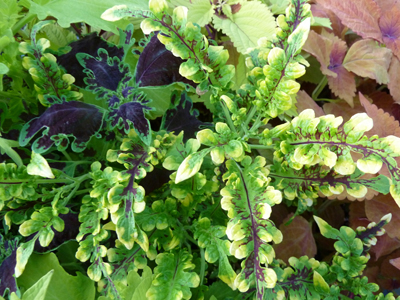
The inspiration for the cultivar name 'Swallowtail' can be seen in the unique shape of the leaves. photo credit: J. Coceano
Take a look at any reference book, i.e. Coleus, Rainbow Foliage for Containers and Gardens by Ray Rogers or browse the 1,143 referenced cultivars on www.coleusfinder.org and you’ll quickly be overwhelmed by the sheer number of varieties. Where did all the cultivars come from? First, Solenostemon can be propagated by seed. As each seedling will be unique, the potential is unlimited. The downside is the tendency of these seedlings to flower quickly, an unfavorable characteristic in Solenostemon. Once flowering is initiated, the overall aesthetic quality of the plant quickly decreases. Flowering leads to seed, then death. Some intentional hybridizing, or seedling-grown crosses are occurring. Alternatively, Solenostemon frequently mutate resulting in sports and reversions. A sport can be selected, asexually propagated, named, and marketed by any commercial nursery, further increasing the number of cultivars offered.
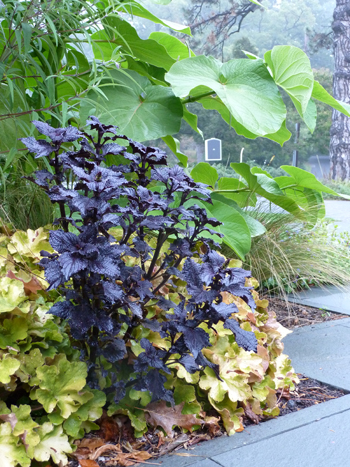
The leaves of Solenostemon 'Shiny Shoes' add a lovely sheen to your garden. photo credit: J. Coceano
Why is coleus so appealing? I learned a valuable lesson when I first started working with containers. It was shared that an effective container combination should be 2/3 foliage to 1/3 flower. While we are often drawn to flowers, their fleeting nature may lead even the best-conceived container to look commonplace throughout the growing season. Eye-catching foliage, on the other hand, always looks good. Solenostemon can fit into just about any annual design. Plants partner well with neighbors and the bevy of colors and color combinations are sure to match any color scheme. A true sight to behold is a coleus standard, or a single plant trained to resemble a small tree. Coleus, Rainbow Foliage for Containers and Gardens by Roy Rogers provides training tips for the curious. Coleus looks fantastic in mass, providing blocks of color that draws the eye.
Plants are relatively pest free, although mealy bugs can be a problem while overwintering indoors. Culturally, Solenostemon are low maintenance. Some shade is beneficial and plants should be kept well watered. Coleus benefits from regular pinching. Pinching involves snipping or pruning above a node. This act encourages the plant to become bushier and fuller in appearance. Otherwise, plants can become leggy and are likely to break from wind or their own weight. Remove any flowers that appear.
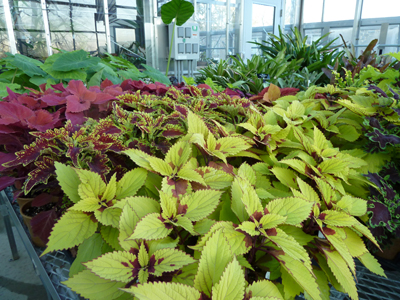
Our 2013 Solenostemon crop growing in the Wister Greenhouse in anticipation of container planting this spring. photo credit: J. Coceano
With trailing and upright cultivars, further divided by distinctive leaf shapes and sizes you just may find yourself catching the coleus craze. Solenostemon may not be the easiest word off the tongue but are coleus are easy to grow and equally easy to share with fellow gardening friends. Explore the wonderful world of Solenostemon at the Unique Tropicals and Annuals Sale May 17 to 19, 2013 at the Scott Arboretum.





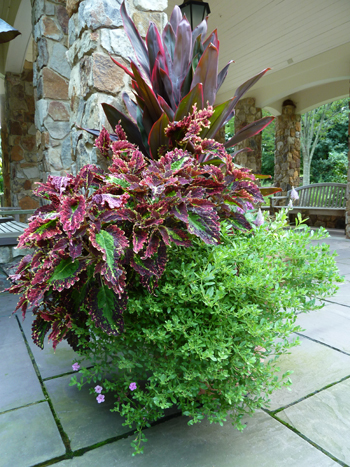
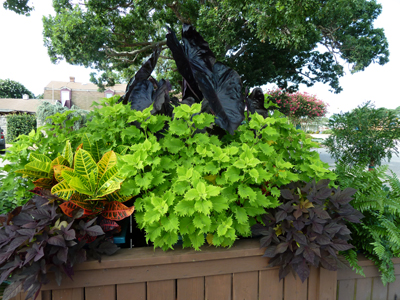
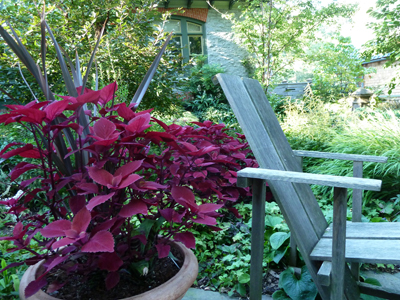
judy penney
Posted at 08:11h, 21 MarchJosh, what a great article!
Stumbled upon it while looking for coleus to befriend the salvias for SHS plant sale.
Beautiful pics and so much info –thanks
Judy